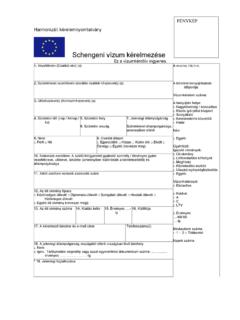Transcription of Facing Difficulties in the Acquisition of the English ...
1 Acta Universitatis Sapientiae, Philologica, 2, 2 (2010) 312-325. Facing Difficulties in the Acquisition of the English Passive by L1 Speakers of hungarian Enik TANK . University of Bucharest Languages and Cultural Identities Doctoral School Abstract. hungarian learners of English encounter Difficulties when learning the passive constructions. Based on my classroom experience, passive is one of the most difficult phenomena when it comes to teaching it, and therefore it is well worth some investigation. Furthermore, the direct method does not allow possibilities for presenting hungarian structures corresponding to the passive voice in English , as a consequence hungarian students learning English as a foreign language use the passive constructions erroneously or will totally avoid using them.
2 The present paper will demonstrate with empirical evidence that, leaving the direct method aside for a while, presenting properly the characteristics of the English passive and its hungarian counterpart structures, with some practice, we can get students to understand, form and use the passive constructions in appropriate contexts. The intervention provides a methodological model for teaching the English passive voice. Keywords: passive construction, L1 conditioning, SLA. 1. Introduction The aim of the present paper is to map the Difficulties hungarian children encounter when learning and using the English passive voice, and also to propose some solutions for the enlisted problems. At the same time, we will provide 312.
3 Facing Difficulties in the Acquisition of the English Passive by L1 Speakers of hungarian 313. empirical evidence that with practice students can be guided towards properly understanding and correctly using structures that are different in their mother tongue. 2. The problem Some linguists argue that there is no real passive voice in hungarian (see Siewierska 1984, MacWhinney, Pl h and Bates 1985); others claim that there is ( , Alberti 1996, or M rkus 2008), considering the predicative verbal adverbial construction a real passive structure. (1) A c g meg van alap tva. the company PERF The company has been founded.' (Kert sz 2005: 12). As an English teacher, I have experienced that the passive voice is one of the most difficult phenomena when it comes to teaching it, explaining it and using it.
4 In spite of the fact that L1 speakers of hungarian in Transylvania also learn about Romanian passive structures, which are very similar to the English passive constructions regarding their structure, form and use, students commit a series of mistakes when using the passive structures, and in essays and other freely composed texts they almost totally avoid using the passive. The question arises: to what extent do native speakers of hungarian understand and acquire the English passive voice? An important issue of the problem is that, from an information-structure point of view, the English passive has several corresponding structures in hungarian . The third person plural form of the verb, generic reading (2) Meg-vizsg lj k a gyermek-et.
5 PERF-examine: the child-ACC. They examine the child.'. Though the sentence in Example (2) literally means [They] examine the child., it is more commonly meant as The child is examined. The fact that this sentence behaves like a passive voice is shown by the fact that the above (third person plural) form can be used even when only one agent is meant ( , The child is examined by one doctor). This is due to the fact that whereas English uses word order as the main way to case/role assignment (Bates et al. 1982), hungarian allows word order to vary and relies on case marking in order to determine who does what to whom . 314 E. Tank . The predicative verbal adverbial construction In the perfect aspect, passive can be expressed by the existential verb van to be' plus the adverbial participle form ending in -va/-ve, , be van csukva it is closed'.
6 This construction is used when the result of the action is emphasized. (3) Az ajt be van csuk-va. the door PERF The door has been closed.' (de Groot 1989: 196). It is important to highlight that this type of structure is compatible with transitive and unaccusative verbs, as shown in the examples below: (4) a. A k v meg van r l-ve. the coffee PERF The coffee has been ground.'. b. A t be van fagy-va. the lake PERF The lake is frozen.' (Kert sz 2005: 2). Gr tsy and Kovalovszky (1980) mention that the predicative verbal adverbial construction implies a change of state. According to Alberti (1996, 1998), the change must be physically noticeable, otherwise the structure will not be correct. Compare the following sentences: (5) a.
7 Az aut le van fest-ve. the car PERF be: The car has been painted.'. b. *A k nyv el van olvas-va. the book PERF be: The book has been read.' (Kert sz 2005: 6). In contrast, English passive structures are acceptable even if no physically noticeable change occurs as a result of the action denoted by the verb. (6) a. The book has been read. b. Tom was seen at the cinema. We can form the predicative verbal adverbial construction by replacing the existential verb with lett/lesz become', as well, thus introducing more dynamicity Facing Difficulties in the Acquisition of the English Passive by L1 Speakers of hungarian 315. into the sentence. From the point of view of dynamicity, the predicative verbal adverbial construction with lett/lesz resembles the English get-passive.
8 (7) a. Az asztal le lesz fest-ve holnap. the table PERF become: tomorrow The table will be painted tomorrow.'. b. Az asztal le lett fest-ve tegnap. the table PERF become: yesterday The table got painted yesterday.' (Laczk 1995: 190). Active sentence with the direct object in topic position (8) A k nyvet be-csomagoltam. the book-ACC PERF-pack: I have packed the book.'. The topic is an element extracted from the verbal phrase and occupies the position on the left periphery of the hungarian sentence. It names the individual about which the predicate of the sentence states something ( . Kiss et al. 2003). Regarding its form, it has to be definite, as it denotes an individual asserted to be existing by both the speaker and the listener (.)
9 Kiss 2008). Active sentence with the DO in topic position and the subject in focus (9) Ezt az aut t DESAP M v s rolta. this-ACC the car-ACC buy: This car has been bought by my father.'. Compared to the previous construction, here the subject, too, occupies an emphasized position (besides the direct object), i. e., it is in focus position, carrying the main accent. The focus exhaustively identifies a subset of a previously (contextually or situationally) determined set of individuals for which the assertion contained by the verbal phrase is true ( . Kiss 2006a, 2006b, 2009). The element carrying the main accent occupies the pre-verbal position, and no modifier can intervene between them.
10 The first element of the predicative phrase is supposed to be stressed, however the focus extirpates the accent of the element standing right next to it ( . Kiss et al. 2003). 316 E. Tank . The archaic synthetic passive form hungarian used to have a synthetic (verbal) passive, formed with the suffix . tat/-tet. In the codices these passive forms are used very frequently. However, they occur extremely rarely in contemporary hungarian , and only with certain verbs. For example: sz letik be born', from sz l give birth', adatik be given', from ad give', viseltetik owe somebody certain feelings', from visel bear', foglaltatik be included', from (mag ba) foglal include'. It must be also mentioned that though used, most of these forms (except for sz letik) are considered archaic.





